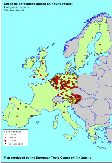4.2 Annual
statistics, 1995
The geographical distribution of
98-percentile values calculated on the basis of hourly
concentrations is presented in Map 3 for background stations and
in Map 4 for urban, street and other stations.
Similar to the observations in 1994 (de
Leeuw et al., 1995) the 98-percentiles at background
stations show in general low values in the Scandinavian
countries, and an increase from North-West to Central Europe. In
particular for the stations in Austria, the elevated location of
the monitoring stations may play a role. For summer 1993 and 1994
similar patterns have been estimated from measurements made
within the framework of EMEP (Hjellbrekke, 1996). However, the
relatively low values observed in the EMEP data over the Iberian
peninsula are not fully supported by the present observations
which might be caused by differences in year, in averaging period
and in set of reporting stations.
For urban and 'other' stations (Map 4) no
large scale concentration gradient in 98-percentiles is
recognized; high values are observed all over the continent. The
local conditions (at stations downwind of the urban area
relatively high ozone values might be observed whereas at
stations with NOx sources such as traffic in their immediate
surrounding relatively low ozone levels will be measured, see
Annex II) seems to be more important than European-wide smog
episodes. For example, in Athens the observed 98-percentile
values of hourly average concentrations ranges from 79 on station
Patission to 173 µg/m3 on station Marousi. The interaction with
(local) NOx emissions (see also Annex II) is shown in the
observed NO2 concentration: at Patission the highest yearly
averaged NO2 concentration (95 µg/m3) is observed whereas at
Marousi one of the lowest NO2 yearly averaged has been observed
(36 µg/m3).
The 98-percentile values based on moving
eight-hourly average concentrations show a strong correlation
with the hourly 98-percentile: on the average, 8-h percentiles
are about 5% lower, see Figure 1. The geographical
distribution of the 8-h percentile values is very similar to the
distribution of the 1-h percentile values.
Figure 1. Relation between 98-percentiles values
based on hourly concentrations and 8-hourly concentration at all
reporting stations (in µg/m3; 1 January-31 December 1995).


Document Actions
Share with others